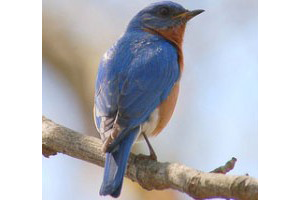Males and females of nesting pairs of eastern bluebirds commonly engage in copulations with other eastern bluebirds. As a result, some nests contain nestlings with different fathers.
Photo Credit: Joby Joseph
Sialia sialis
Common Name: eastern bluebird
Animal Guild: Bird
Class > Order > Family: Aves > Passeriformes > Turdidae
What does the species look like?
Male has blue upperparts, red-orange throat, breast, and flanks, and white lower belly and undertail coverts. Female has blue-gray upperparts, a gray-brown wash across the back, sometimes a vague white eye-ring; the wings and tail are dull blue; and the underparts are paler orange than on male. Both sexes have a short, stout, black bill. Birds in winter are generally duller and more grayish. Juveniles are browner than are adults, with white streaking above and dusky spotting below, and have a white eye-ring. Length is around 7 inches (18 cm).
Where is the species found?
States & Provinces
AL, AR, AZ, CO, CT, DE, FL, GA, IA, IL, IN, KS, KY, LA, MA, MB, MD, ME, MI, MN, MO, MS, MT, NB, NC, ND, NE, NH, NJ, NM, NS, NY, OH, OK, ON, PA, PE, QC, RI, SC, SD, SK, TN, TX, VA, VT, WI, WV, WY
Distribution
Breeding range extends from southern Saskatchewan east across southern Canada to Nova Scotia, and south to Nicaragua, the North American Gulf Coast, southern Florida, and Bermuda, and west to the western Great Plains; also southeastern Arizona. Winter range extends from the middle portions of the eastern United States south through the breeding range and western Cuba and also includes areas outside the breeding range in Texas and New Mexico.
Habitat includes forest edge, open woodland, and partly open situations with scattered trees, from coniferous or deciduous forest to riparian woodland, also pine woodland or savanna in the tropics. Nests are in natural cavities, old woodpecker holes, bird boxes, or similar sites, mostly 3-20 feet (1-6 meters) above ground.
General Phenology and Life History
Northward migrants arrive in northern breeding areas mostly in March-April but sometimes as early as late February. Southward migration occurs mainly from September-November. Nesting period varies with location and may begin as early as late February in some areas and extend into late summer. Clutch size is usually 4-5. Individual females in most areas produce 2 broods/year, sometimes 3, and very rarely 4. Incubation, mainly by the female, lasts 11-19 (generally around 14) days. Young are tended by both parents and leave the nest at 15-20 days. Male tends fledged young if female renests. Young of the first brood may help feed the second brood.
Which phenophases should I observe?
Do you see/hear...?
Activity
Live individuals More...
For abundance, enter the number of individual animals observed in this phenophase.
Feeding For abundance, enter the number of individual animals observed in this phenophase.
Fruit/seed consumption For abundance, enter the number of individual animals observed in this phenophase.
Insect consumption For abundance, enter the number of individual animals observed in this phenophase.
Calls or song For abundance, enter the number of individual animals observed in this phenophase.
Singing individuals For abundance, enter the number of individual animals observed in this phenophase.
Territorial individuals For abundance, enter the number of individual animals observed in this phenophase.
Reproduction
Courtship For abundance, enter the number of individual animals observed in this phenophase.
Mating For abundance, enter the number of individual animals observed in this phenophase.
Nest building For abundance, enter the number of individual animals observed in this phenophase.
Occupied nest For abundance, enter the number of individual animals observed in this phenophase.
Development
Nestlings For abundance, enter the number of individual animals observed in this phenophase.
Fledged young For abundance, enter the number of individual animals observed in this phenophase.
Dead individuals For abundance, enter the number of individual animals observed in this phenophase.
Dead nestlings or fledglings For abundance, enter the number of individual animals observed in this phenophase.
Method
Individuals at a feeding station For abundance, enter the number of individual animals observed in this phenophase.
What do these phenophases look like?
There is currently no photoguide available for this species. If you'd like help us create one, use the guidance document and species template provided here . Then send it via email to education@usanpn.org when it is complete.
